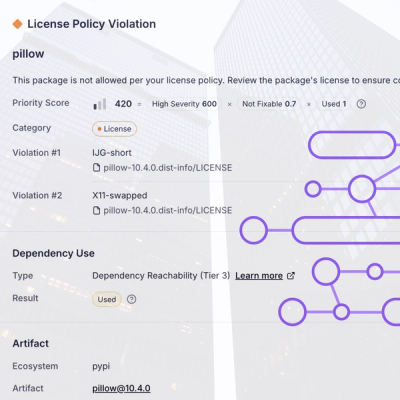
Research
/Security News
Critical Vulnerability in NestJS Devtools: Localhost RCE via Sandbox Escape
A flawed sandbox in @nestjs/devtools-integration lets attackers run code on your machine via CSRF, leading to full Remote Code Execution (RCE).
what-input
Advanced tools
A global utility for tracking the current input method (mouse, keyboard or touch).
A global utility for tracking the current input method (mouse, keyboard or touch).
Now with more information and less opinion!
What Input adds data attributes to the window based on the type of input being used. It also exposes a simple API that can be used for scripting interactions.
What Input uses event bubbling on the window to watch for mouse, keyboard and touch events (via mousedown, keydown and touchstart). It then sets or updates a data-whatinput attribute.
Pointer Events are supported but note that pen inputs are remapped to touch.
What Input also exposes a tiny API that allows the developer to ask for the current input, set custom ignore keys, and set and remove custom callback functions.
What Input does not make assumptions about the input environment before the page is interacted with. However, the mousemove and pointermove events are used to set a data-whatintent="mouse" attribute to indicate that a mouse is being used indirectly.
Check out the demo to see What Input in action.
https://ten1seven.github.io/what-input
Since interacting with a form always requires use of the keyboard, What Input uses the data-whatintent attribute to display a "buffered" version of input events while form <input>s, <select>s, and <textarea>s are being interacted with (i.e. mouse user's data-whatintent will be preserved as mouse while typing).
Download the file directly.
Install via Yarn:
yarn add what-input
Install via NPM:
npm install what-input
Include the script directly in your project.
<script src="path/to/what-input.js"></script>
Or require with a script loader.
import 'what-input'
// or
import whatInput from 'what-input'
// or
require('what-input')
// or
var whatInput = require('what-input')
// or
requirejs.config({
paths: {
whatInput: 'path/to/what-input',
},
})
require(['whatInput'], function () {})
What Input will start doing its thing while you do yours.
By default, What Input uses session storage to persist the input and intent values across pages. The benefit is that once a visitor has interacted with the page, subsequent pages won't have to wait for interactions to know the input method.
This behavior can be disabled by adding a data-whatpersist="false" attribute on either the <html> or <body>.
<html dir="ltr" lang="en" data-whatpersist="false">
...
</html>
or
<body data-whatpersist="false">
...
</body>
Session storage can be cleared at any time with:
whatInput.clearStorage()
/*
* only suppress the focus ring once what-input has successfully started
*/
/* suppress focus ring on form controls for mouse users */
[data-whatintent='mouse'] *:focus {
outline: none;
}
Note: If you remove outlines with outline: none;, be sure to provide clear visual :focus styles so the user can see which element they are on at any time for greater accessibility. Visit W3C's WCAG 2.0 2.4.7 Guideline to learn more.
Ask What Input what the current input method is. This works best if asked after the events What Input is bound to (mousedown, keydown and touchstart).
whatInput.ask() // returns `mouse`, `keyboard` or `touch`
myButton.addEventListener('click', () => {
if (whatInput.ask() === 'mouse') {
// do mousy things
} else if (whatInput.ask() === 'keyboard') {
// do keyboard things
}
})
If it's necessary to know if mousemove is being used, use the 'intent' option. For example:
/*
* nothing has happened but the mouse has moved
*/
whatInput.ask() // returns `initial` because the page has not been directly interacted with
whatInput.ask('intent') // returns `mouse` because mouse movement was detected
/*
* the keyboard has been used, then the mouse was moved
*/
whatInput.ask() // returns `keyboard` because the keyboard was the last direct page interaction
whatInput.ask('intent') // returns `mouse` because mouse movement was the most recent action detected
Ask What Input the currently focused DOM element.
whatInput.element() // returns a string, like `input` or null
Set a custom array of keycodes that will be ignored (will not switch over to keyboard) when pressed. A custom list will overwrite the default values.
/*
* default ignored keys:
* 16, // shift
* 17, // control
* 18, // alt
* 91, // Windows key / left Apple cmd
* 93 // Windows menu / right Apple cmd
*/
whatInput.ignoreKeys([1, 2, 3])
Set a custom array of keycodes that will trigger the keyboard pressed intent (will not switch to keyboard unless these keys are pressed). This overrides ignoreKeys.
// only listen to tab keyboard press
whatInput.specificKeys([9])
Fire a function when the input or intent changes.
// create a function to be fired
var myFunction = function (type) {
console.log(type)
}
// fire `myFunction` when the intent changes
whatInput.registerOnChange(myFunction, 'intent')
// fire `myFunction` when the input changes
whatInput.registerOnChange(myFunction, 'input')
// remove custom event
whatInput.unRegisterOnChange(myFunction)
What Input works in all modern browsers.
data-whatpersist before DOMContentLoaded. Fix via FanFataL.useCapture so events can be detected before preventDefault cancels them on local listeners (h/t jojo080889).DOMContentLoaded event before looking for data-whatpersist attribute on body.dataset in IE10.data-whatpersist="false" attribute to the <html> or <body> tag to disable usage of session storage to persist input/intent across pages.activeElement is null bug in IE is fixed (thanks @EasterPeanut).mouse because of event execution order.touchend to input maptouchend to input mapspecificKeys functionality to allow overriding of keyboard keys list. Fix via bk3.unRegisterOnChange failed to unregister items at index 0.whatInput.registerOnChange and whatInput.unRegisterOnChange.data-whatelement attribute exposes any currently focused DOM element (i.e. data-whatelement="a" or data-whatelement="input").data-whatclasses attribute exposes any currently focused element's classes as a comma-separated list (i.e. data-whatclasses="class1,class2").data-whatinput attribute immediately reflects the current input. The data-whatintent attribute now takes on the role of remembering mouse input prior to typing in or clicking on a form field.data-whatinput attribute reflects the current input (switches to "keyboard").whatInput.types() API option.shift, control, alt, cmd) no longer toggles back to keyboard.Special thanks to Viget for their encouragement and commitment to open source projects. Visit code.viget.com to see more projects from Viget.
Thanks to mAAdhaTTah for the initial conversion to Webpack. Thanks to greypants for adding TypeScript definitions.
What Input is written and maintained by @ten1seven.
What Input is freely available under the MIT License.
FAQs
A global utility for tracking the current input method (mouse, keyboard or touch).
The npm package what-input receives a total of 126,621 weekly downloads. As such, what-input popularity was classified as popular.
We found that what-input demonstrated a not healthy version release cadence and project activity because the last version was released a year ago. It has 1 open source maintainer collaborating on the project.
Did you know?

Socket for GitHub automatically highlights issues in each pull request and monitors the health of all your open source dependencies. Discover the contents of your packages and block harmful activity before you install or update your dependencies.

Research
/Security News
A flawed sandbox in @nestjs/devtools-integration lets attackers run code on your machine via CSRF, leading to full Remote Code Execution (RCE).

Product
Customize license detection with Socket’s new license overlays: gain control, reduce noise, and handle edge cases with precision.

Product
Socket now supports Rust and Cargo, offering package search for all users and experimental SBOM generation for enterprise projects.